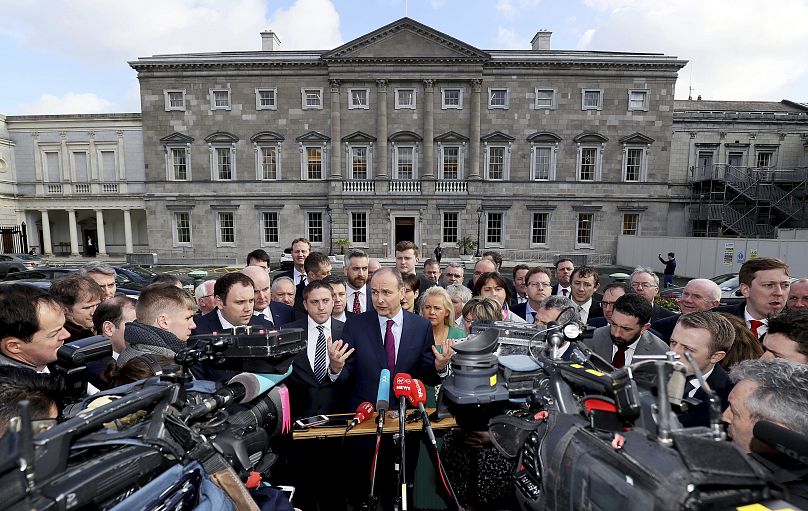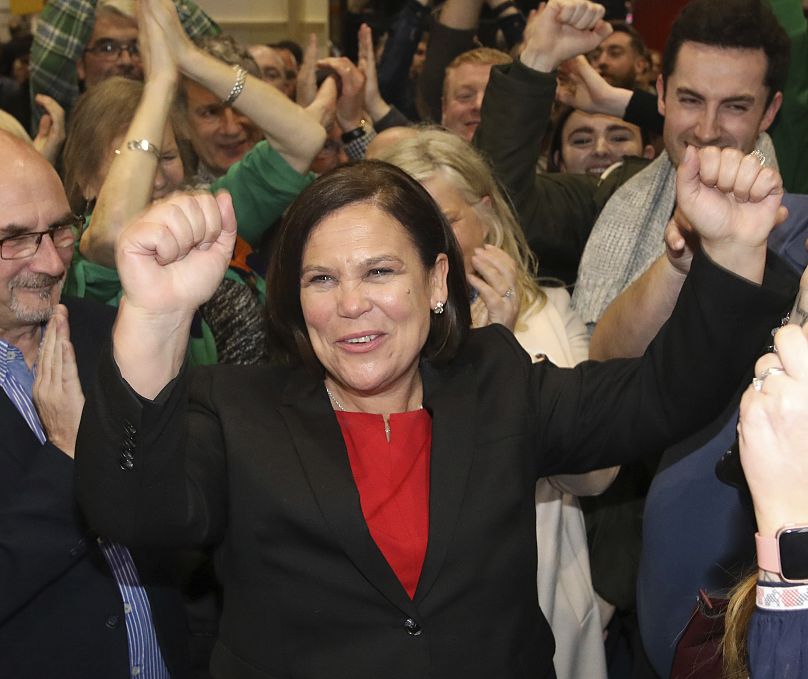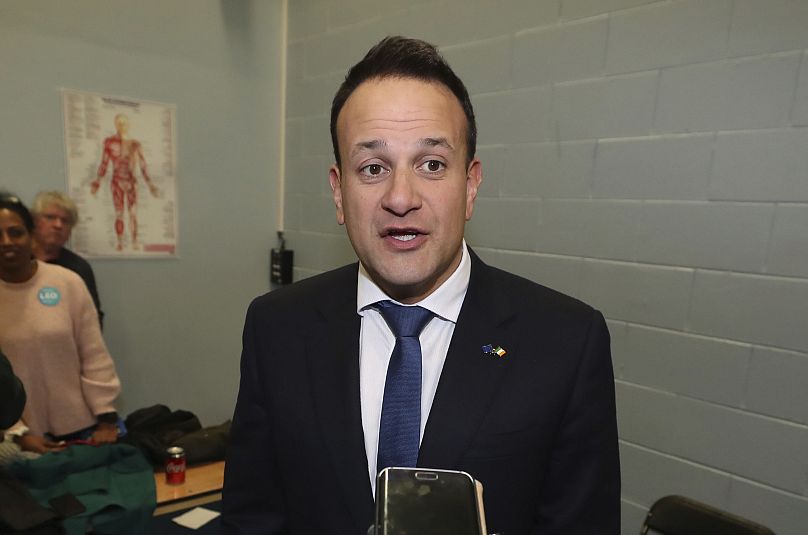Two age-old political rivals have agreed to enter a partnership in a bid to form an Irish government. But why is this significant and what's next?
In one of the most tumultuous times in modern history, the Irish political scene is facing an overhaul, with two age-old enemies agreeing to form a coalition amid the pandemic.
The historical divide between Fine Gael and Fianna Fail lies deep in history and decades of political rivalry. This week, both agreed to a political framework that could form the basis of them entering government together.
Euronews spoke with Irish political correspondent with Virgin Media, Gavan Reilly, to detail the significance of the agreement made between the two parties and the stumbling blocks ahead in order to form a government.
Historically, what was the relationship between Fianna Fail and Fine Gael?
"Fianna Fail and Fine Gael have always really been the two beasts of Irish politics," Reilly said, likening their stature in the Irish political sphere to Democrats and Republicans in the United States. Both seen as centre-right, have traditionally been the only two significant parties in the country. "It's very difficult to think of one without being defined by the other".
The political landscape, with either Fianna Fail or Fine Gael standing at the helm, has remained steadfast for decades.
"It's always been the case since independence nearly 100 years ago that either one or the other has been in government and basically, for the last nine decades, every general election has largely been fought between one and the other," Reilly noted.
The to and fro between the parties stems back to Irish history, where both "grew out of what were opposing sides of the Irish civil war".
One side became Fine Gael, "the slightly more pragmatic side who were prepared to accept semi-independence from the British Empire". The other became Fianna Fail, who "rejected that treaty and wanted an absolutely clean break".
Although the war ended in 1923, the warring sides evolved into the two largest parties in the country.
"They have always been at each other's throats for nearly a century now and it is only the most recent election that has forced them to reconsider that attitude," Reilly told Euronews.
The pair have a history of cooperation
Although both parties have, for decades, been rivals vying for political power, they have both collaborated in the past. In the late 1980s, Ireland was in "particularly dire financial straits," Reilly said. In what was coined the "Tallaght Strategy", Fine Gael gave backing to Fianna Fail, who were in government, to make difficult economic reforms.
"That, in itself, was historic at the time because you already had these two parties which had been at each other's throats for nearly seventy years agreeing to part usual animosity where Fine Gael would not oppose certain financial measures as long as they thought they were the right thing to do," he said.
Decades later, in 2016, the pair reached another consensus in a confidence-and-supply arrangement. The Tallaght Strategy "was only a diet version of what we have had in Ireland over the last four years". Although Fine Gael won the last general election, they failed to gain enough seats for an absolute majority nor did they have enough coalition partners to form a majority government.
"The only way any government could have been formed at the time was for Fianna Fail, who were by now in opposition, to basically have a confidence-and-supply deal where they were able to abstain in certain major votes, they were able to facilitate the appointment of a Fine Gael government in exchange for certain policy concessions," he said.
That relationship "has to lead a lot of people outside of those two parties to really perceive that those two have been effectively been in government together for the last four years. That is not an attitude which is shared within those parties".
"There is a certain history of collaboration when the times are necessary but not nearly on the scale we are likely to see now."
A shake-up of the political class after the 2020 election
Ireland has already seen a major shift in the political sphere following the election in February, where Sinn Fein, traditionally a minor party, gained significant ground whilst taking nearly a quarter of the votes. Sinn Fein, seen as centre-left, won the most first preference votes amounting to 37 seats, totalling the same as Fianna Fail and two greater than Fine Gael.
The slump for the Fianna Fail and Fine Gael, and the surge for Sinn Fein, came off the back of a close relationship between the two centre-right rivals, with some perceiving that "Fine Gael and Fianna Fail had basically been in government together for the previous four years".
"That government had presided over, not only the continuing major health crisis where pre-pandemic we used to see hundreds of people on hospital trollies waiting for treatment every day, where people could literally be waiting years for an appointment with a public health consultant. But also a major housing crisis," Reilly said, with an annual national rent increase of above 10 per cent between 2016 to late 2018.
Younger people have felt most victimised by the housing shortage and subsequent soaring rent prices.
"They hold Fianna Fail and Fine Gael jointly responsible for that and Sinn Fein came along with a very ambitious program of public house building to try and ease those concerns and Sinn Fein did very well off the back of that," he said.
Where does Sinn Fein stand?
The political playbook with Ireland as a two-party political system was ripped up following the election amid the emergence of Sinn Fein.
"All three parties have a broadly equal size in the new Irish parliament," Reilly said, but noted that no two can "collaborate together to claim absolute majority which is what has forced Fine Gael and Fianna Fail to consider the sort of options that are on the table that they've never had to contemplate before".
Fine Gael and Fianna Fail have also refused to enter talks with Sinn Fein, and both parties sparred with the latter during the election campaign.
"They believe that Sinn Fein still remains sympathetic to the previous IRA campaigns of Northern Ireland in the past, there are some allegations that Sinn Fein is still secretly run by a cabal of unelected insiders," said Reilly
"Those are, of course, allegations that Sinn Fein has completely denied but are ideas which have currency among the ordinary members of Fine Gael and Fianna Fail. It seems that they have reached a decision on how that they would rather embrace their historical rivals than the new kid on the block," Reilly said.
"During the pandemic, there has been a sort of detente in Irish politics where, because we don't have a new government yet, the previous outgoing Fine Gael government is still in sort of a care-taker mode and there has been, by-in-large, been a political consensus around the things that it has needed to do," avoiding a fracturing in the political system during the pandemic.
Although the government has been able to introduce measures such as an emergency welfare system and payment schemes, the political murmurings that a government needs to form has not subsided. The decisions being made are have been done "with the recognition that a care-taker government can't linger through this crisis forever".
What are the main stumbling blocks now for Fine Gael and Fianna Fail?
Although the two parties reached a policy framework agreement, they have hurdles ahead, a key challenge being their own internal history.
"They'll find it very difficult that they are now required to go into government alongside a historical enemy," he said.
The two will also need to find a coalition partner, with Fine Gael and Fianna Fail falling about 10 per cent short from an absolute majority.
"And of course, the dynamics in a government like that, where you have two larger parties and then one smaller one, may lead you to think that those smaller parties could be completely overruled - that they might only get a very small number of policy concessions from Fine Gael and Fianna Fail but otherwise that they could have no influence in a government where they could be perceived as the mudguard," Reilly said.
The Irish electorate has punished junior partners in the past and has a history of doing so.
"The Green Party has been that partner before," said Reilly. "We've had the Progressive Democrats which were the junior partners in previous governments, who were treated so badly by the electorate that they disbanded afterward. The Labour Party were the junior partner in the middle of Ireland's austerity-era, they have never really recovered from the electoral defeat that they've had since then."
No matter which parties form a government, there are major obstacles ahead
The memory of the 2008 crash and the austerity that followed lingers strongly on Irish minds. The economy, however, made a rebound.
"Ireland has come from having unemployment of about 15 per cent in the early part of the last decade to having unemployment at about 4.5 per cent at the end of the decade, which is an incredible transformation," he said.
The pandemic has swept much of that success away, with a spike in the number now claiming unemployment benefits, leaving Ireland in the midst of significant financial debt.
"Ireland is likely to run a deficit of about €21 billion this year according to calculations by the Central Bank. That means that every €2 that it's taken in, it's spending three. That is clearly not something that can be bridged overnight," Reilly said.
"Arguably, you could say that it doesn't matter who is going to be in government now when at the end of these talks has finally happened, that nobody really has the mandate to make the very, very difficult decisions that are going to be needed."














